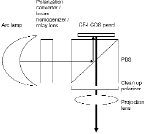The Case for Color-Filter–on–Chip LCOS

by Hoi-Sing Kwok
Liquid-crystal–on–silicon (LCOS) technology has not been too successful in penetrating the rear-projection-television (RPTV) market. One main reason is that existing LCOS solutions are too expensive and the optical engine too complicated. Recently, we have disclosed a new LCOS technology based on integrated color filters (CFs) that we have developed at Integrated Microdisplays, Ltd. [U.S. Patent No. 6,793,344; SID Symposium Digest Tech. Papers 36, 1302–1305 and 880–883 (2005)]. I genuinely believe that color-filter–on–chip LCOS (CF-LCOS) technology offers an excellent alternative approach to LCOS RPTV.
CF-LCOS is LCOS made with a CF deposited directly onto the silicon backplane. It requires micro-CF technology similar to that used in CCD and CMOS sensors. By using CF-LCOS, full-color RPTV can be developed without complicated optics and electronics, and a single polarizing beam splitter (PBS) can be used (shown in the figure). There is no complicated color separation/recombination optics as in a three-panel system, and there is no complicated electronics for storing sub-frame information as in a time-sequential color (TSC) system. The CF-LCOS panel is similar to a miniature LCD TV, and, like an LCD TV, can have excellent saturated colors. We have recently fabricated a 720 x 1280 x 3 CF-LCOS panel with a 0.87-in. diagonal, and it performs well.

It is surprising that despite the large amount of light absorbed by the CF (almost 70%), the CF-LCOS chip does not heat up significantly simply because the thermal resistance of the silicon wafer plus the CF is very low, about 10-5 K/W/m2. The thermal loading on the CF-LCOS is, of course, related to the amount of light shining on it. For a 55-in. RPTV with a 420-lm output and a modest optical efficiency of 15%, the optical power falling onto the CF-LCOS panel is 2800 lm, or about 28 W. So, the heat that must be dissipated is about 20 W, similar to the heat dissipation of a computer CPU chip. If the diagonal of the display area is 0.87 in., the heat flow will be 1.5 x 105 W/m2 and the temperature difference between the top of the CF and the bottom of the silicon wafer is only 1.5°. The temperature of the CF and the liquid crystal inside the panel is nearly the same as that of the heat sink! The heat sink has to be carefully designed in order to dissipate that 20 W, but an operating temperature of less than 45°C is definitely possible.
The light intensity on the CF-LCOS panel is intense. For the 55-in. RPTV, it is about 12 million lux. The CF is not affected by this light as long as there is a good heat sink, but the conventional polyimide alignment layer deteriorates badly in the presence of strong light. The solution is to use evaporated SiO2 as the alignment layer, which is convenient because SiO2 has to be used for vertical-alignment LCOS in any case. And because we are using wafer-scale processing, SiO2 evaporation does not pose a manufacturing problem.
One might expect that because the CF absorbs 70% of the light the optical efficiency would not be competitive with that of conventional approaches. In fact, this absorption is no different from the absorption by the color wheel in a TSC system. So the optical efficiency of a CF-LCOS system is not that different from that of a one-panel LCOS system based on TSC.
The CF-LCOS will have a lower efficiency than that of a three-panel system, but a three-panel system requires more than one PBS. The simplicity of the optical system that can be used with CF-LCOS and its higher light-collection efficiency goes a long way toward compensating for the three-panel system's higher efficiency. In any case, the 0.87-in. one-panel CF-LCOS system is capable of producing a 420-lm output, which is adequate for a 55-in. RPTV and comparable with the output of many of today's commercial systems.
So, the case for CF-LCOS is rather strong. It has many advantages, the most important of which are simple projection optics and low system cost. The optical engine is extremely simple, which leads to much better manufacturability. To make LCOS competitive with digital light processing™, (DLP™) in the RPTV market, the use of CF-LCOS is the obvious way to go. Incidentally, it is also an attractive choice for near-to-eye displays.
Hoi-Sing Kwok is Professor of EEE and Director of the Centre for Display Research at the Hong Kong University of Science & Technology. He is a co-founder of Integrated Microdisplays, Ltd.; telephone +852/2358-7056, fax +852/2358-1485, e-mail: eekwok@ ust.hk.